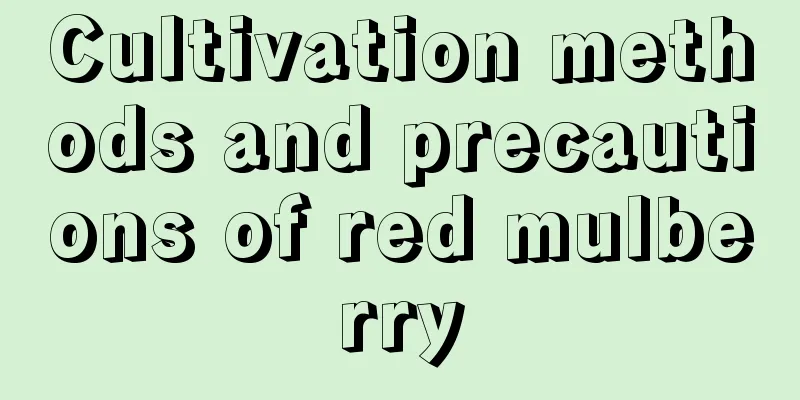Cultivation methods and precautions of red mulberry

1. Maintenance methods1. Soil: When planting red mulberry, it is best to mix garden soil and leaf mold. When the red mulberry is potted, a small amount of base fertilizer at the bottom can meet its growth needs. 2. Watering: It likes a humid growing environment. When caring for it during the growth period, it is best to keep the soil in the pot slightly moist. In summer, water it as much as possible because water evaporates more quickly. 3. Fertilization: Red mulberry has a relatively large demand for fertilizer. During its growth period, apply more nitrogen fertilizer to it, basically twice a month. Stop fertilizing after autumn because its growth rate gradually slows down. 4. Light: It will grow better in a warm environment and likes sunshine. When caring for it, try to let it receive sunlight as much as possible. It likes strong light, but still needs appropriate shade in summer. 2. Breeding techniques1. Reproduction: A more convenient way of reproduction is cutting propagation. In June-August, select new or two-year-old branches, insert them into the soil, and wait for them to sprout. 2. Pruning: In order to make the plant fuller, it is necessary to prune and top it during its growth period. This can stimulate the growth of more side branches. With more branches, the shape will be easier to maintain. 3. Problem diagnosis and treatment1. Root rot: In the early stage of root rot, the root system will rot, seriously affecting its absorption capacity, and will directly lead to death in the later stage. The cause of the disease should be checked from the soil. When the disease occurs, it is necessary to use carbendazim and carbendazim to irrigate the roots in time. 2. Leaf spot disease: It mainly manifests as brown circular spots on the leaves, which later spread to the whole plant, seriously affecting photosynthesis and appearance. Spray the leaves with 300 times diluted Trichoderma harzianum in time. IV. Other issues1. Can it be eaten: Red mulberry can be eaten. It has high nutritional value and contains many minerals and vitamins needed by the human body. It is known as the "longevity vegetable". 2. Can it be raised indoors: There is no problem in raising it indoors, but no matter what, the indoor conditions are definitely not as good as those outdoors. In addition, it is easier to be infected by bacteria if it is kept in a closed space for a long time with poor air circulation. It is better to raise it outdoors. |
<<: The cultivation methods and precautions of Albizia julibrissin
>>: Cultivation methods and precautions of monkey face flower
Recommend
Cultivation methods and precautions of Photinia fraseri
1. Soil The soil suitable for the plant to grow i...
Is planting honeysuckle profitable? The cost and profit of planting one acre
Is it profitable to grow honeysuckle? Honeysuckle...
How many years can Verbena be grown?
1. How many years can it be raised? Verbena is lo...
Magnolia language and meaning
1. Flower Language White magnolia is a very pure ...
How to plant peony flowers? Planting time and method
Peony planting time Peonies are generally best pl...
The most indifferent flower in the world
1. Platycodon grandiflorum Its flower language is...
The flower language and meaning of Solanum ovata, and what are the legends?
1. Flower language and meaning 1. Safety and heal...
Beautiful succulent flowers, amazing
Pictures of succulent flowers Beautiful Lotus Lu ...
When will freesia bloom if you plant it?
Freesia is a perennial herb of the genus Freesia ...
What fertilizer should be applied when passion fruit is bearing fruit?
Passion fruit is a tropical fruit . It is sweet a...
The breeding methods and precautions of Chinese giant thorn
Farming methods Repotting For potted Clerodendrum...
Four-season maintenance methods of Staghorn Begonia
Spring maintenance methods for Staghorn Begonia R...
Apple tree management technology in December
With the arrival of December, heavy snow and the ...
What is the black soldier fly and what is its value?
1. What is the black soldier fly? Black soldier f...
The flower language and cultural legend of mint
The flower language of mint Mint has two flower l...









